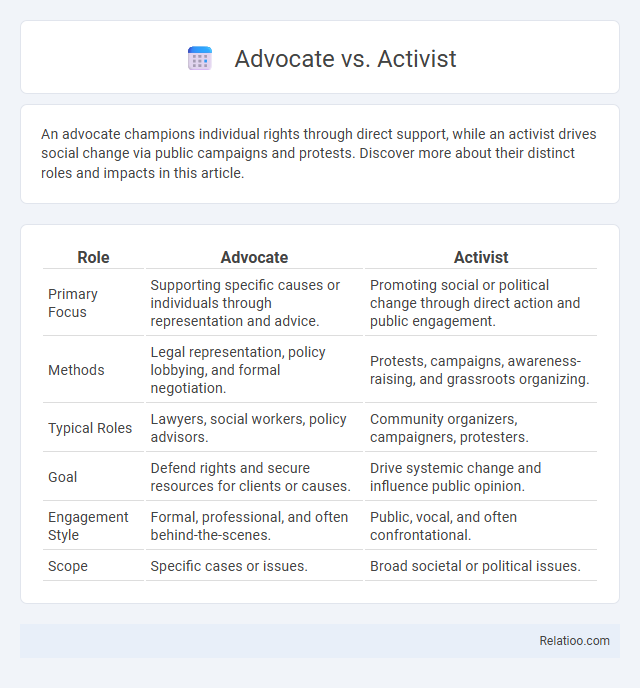An advocate champions individual rights through direct support, while an activist drives social change via public campaigns and protests. Discover more about their distinct roles and impacts in this article.
Table of Comparison
| Role | Advocate | Activist |
|---|---|---|
| Primary Focus | Supporting specific causes or individuals through representation and advice. | Promoting social or political change through direct action and public engagement. |
| Methods | Legal representation, policy lobbying, and formal negotiation. | Protests, campaigns, awareness-raising, and grassroots organizing. |
| Typical Roles | Lawyers, social workers, policy advisors. | Community organizers, campaigners, protesters. |
| Goal | Defend rights and secure resources for clients or causes. | Drive systemic change and influence public opinion. |
| Engagement Style | Formal, professional, and often behind-the-scenes. | Public, vocal, and often confrontational. |
| Scope | Specific cases or issues. | Broad societal or political issues. |
Understanding the Terms: Advocate vs Activist
An advocate actively supports or recommends a cause, often working within established systems to influence policy or decision-making. An activist engages in direct action and public demonstrations to promote social or political change, frequently challenging the status quo. Understanding the differences highlights how advocacy emphasizes persuasion and legal efforts, while activism centers on visible, grassroots mobilization.
Defining Advocacy: What Does an Advocate Do?
Advocacy involves actively supporting or recommending a cause or policy to create change, with advocates serving as the driving force behind these efforts by representing and voicing the needs of individuals or groups. Your role as an advocate includes educating others, influencing legislation, and mobilizing public opinion to address social, environmental, or political issues. Activists may engage in direct action and protest, but advocates typically work within formal channels to ensure sustained and effective change through dialogue and policy development.
The Role of an Activist in Society
An activist plays a crucial role in shaping society by mobilizing communities to address social, political, and environmental issues, often challenging established norms to drive reform. Unlike advocates who typically support specific causes through persuasion and legal channels, activists engage in direct action, including protests and awareness campaigns, to amplify marginalized voices and promote systemic change. Your participation or support in activism can accelerate social justice efforts and foster a more equitable and inclusive society.
Key Differences Between Advocates and Activists
Advocates work within existing systems to promote specific causes through dialogue, policy change, and negotiation, while activists often engage in public demonstrations, direct actions, and grassroots mobilization to drive social or political change. Advocacy emphasizes structured efforts like lobbying and legal action, whereas activism tends to involve more visible, sometimes confrontational tactics to raise awareness and disrupt the status quo. Your understanding of these roles is essential when choosing the most effective approach to influence public opinion or policy.
Methods and Approaches: Advocacy vs Activism
Advocacy employs structured methods such as policy analysis, lobbying, and legal action to influence decision-makers and create systemic change. Activism relies on grassroots mobilization, public demonstrations, and social media campaigns to raise awareness and pressure institutions directly. While advocacy often uses formal channels and strategic communication, activism emphasizes direct action and community engagement.
Skills Required for Advocacy and Activism
Effective advocacy demands strong communication, negotiation, and critical thinking skills to influence policy and represent community interests accurately. Activists require creativity, resilience, and mobilization abilities to organize grassroots campaigns and drive social change. Both roles benefit from empathy and strategic planning, but advocacy leans more on policy knowledge while activism emphasizes direct action and public engagement.
Impact and Outcomes: Measuring Effectiveness
Measuring the effectiveness of advocates, activists, and advocacy efforts involves assessing the tangible impact on policy changes, community empowerment, and social awareness. Advocates often achieve measurable outcomes through strategic lobbying and policy influence, while activists drive grassroots mobilization that shifts public opinion and sparks legislative action. Advocacy combines these approaches to amplify voices, track progress through data analytics, and ensure sustained social transformation.
Famous Advocates and Activists: Notable Examples
Famous advocates like Ruth Bader Ginsburg used legal expertise to champion gender equality and civil rights through landmark court cases, shaping policy changes worldwide. Activists such as Martin Luther King Jr. galvanized mass social movements advocating for racial justice and systemic reform via public protests and speeches. Advocacy encompasses both roles, blending focused legal arguments and grassroots mobilization to promote human rights and social change effectively.
Choosing Your Path: Becoming an Advocate or Activist
Choosing your path involves understanding the distinct roles of advocate and activist; advocates work within systems to promote change through dialogue and policy influence, while activists engage in direct action and public demonstrations to raise awareness and demand reform. Advocacy encompasses both approaches but centers on sustained efforts to support specific causes through education, lobbying, and legal channels. Your decision depends on whether you prefer strategic negotiation or grassroots mobilization to drive social impact.
Working Together: The Intersection of Advocacy and Activism
Advocacy and activism both drive social change by influencing policies and raising awareness, but advocacy often involves formal strategies like lobbying and legal action, while activism centers on grassroots mobilization and public demonstrations. When you combine advocacy's structured approach with activism's passionate energy, their efforts create powerful synergy that accelerates impact and sustains momentum. Working together, advocates and activists amplify each other's voices, ensuring diverse channels for meaningful reform and long-lasting community engagement.

Infographic: Advocate vs Activist
 relatioo.com
relatioo.com